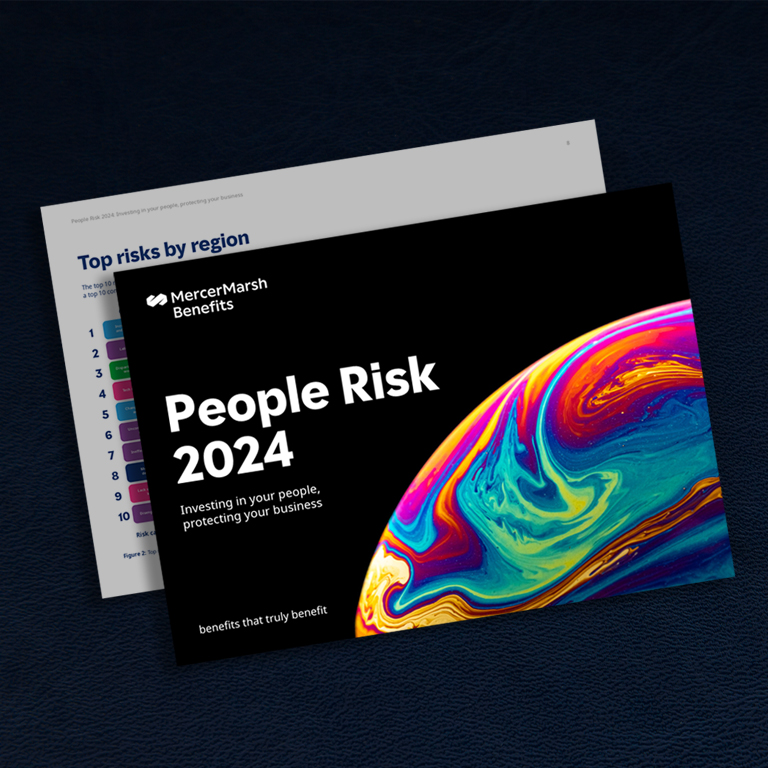Medical inflation refers to the rate at which the cost of medical services and products increases over time.
Double-digit surge of medical trend rates projected in seven out of 10 Asian markets
Employer-provided health plans face intense pressure as the medical trend rate is projected to reach 12.5% in 2026, or close to six times the inflation rate in Asia. Underlying cost drivers include increased utilisation from higher incidence of health conditions and advanced technologies.
Through our Health Trends global research of 268 insurers across 67 markets, including 86 insurers in Asia, learn the top challenges and opportunities for employer-provided health and benefits with these three key trends.
- Three top trends in Asia revealed
Key insights into top trends that will shape your health and benefits program for 2026.
It’s more crucial than ever to proactively manage health plan risks
Understanding these trends and their impact is key for employers, allowing them to design healthcare plans that meet the needs of businesses and employees.
The benefits optimisation curve opportunity
63% of insurers in Asia anticipate reductions in coverage to manage costs in 2026. However, keeping health plans affordable is not just about cutting costs — it’s about building long-term sustainability. With better cost management, dollars saved can be directed back into health plans, creating benefits that all employees will use, trust, and value.
Now is the time for employers to adopt strategic measures that can manage costs and optimise spending to sustain and protect healthcare plans.
Report FAQs
The Health Trends report is a comprehensive survey of insurers, designed as a guide to support active plan management that balances coverage adequacy and cost sustainability. The trends outlined in this report will help employers deepen dialogue with their advisors and insurers. Exploring more innovative forms of cost containment, embracing effective new treatment regimes, and ensuring that medical coverage meets the needs of the whole workforce are essential as medical costs rise and workforce needs evolve. It provides insights into potential challenges and opportunities for benefits decision-makers across a number of industries.
The Health Trends report is essential reading for benefits decision-makers within organisations, including leaders and managers of human resources, rewards, compensation and benefits, risk, finance, insurance and C-level executives. The report is relevant to different industries and all sizes of organisations, including global HR professionals of multinational firms.
It is a key resource for employers who want to reassess their health and benefits plans to optimise value for their business and employees as they head into 2026.
The Mercer Marsh Benefits (MMB) Health Trends report stands out for its comprehensive analysis, expert insights, and forward-thinking approach. It is developed by Mercer Marsh Benefits, along with other subject matter experts in human resources, insurance, and risk consulting across Marsh, and is considered one of the leading sources of information about the medical conditions that drive claims costs and frequency, their impact, and how cost-management will ensure sustainability over the longer-term. The results are from our insurer survey, which is differentiated from others in the market by its size, geographic scope, and insurer responses.
To produce our Health Trends 2026 report, Mercer Marsh Benefits (MMB) surveyed 268 insurers across 67 markets to explore the key trends shaping employer-provided health benefits. The survey was fielded in June and July 2025.
These trends are important for employers to consider as the ongoing need for cost containment is likely to continue throughout 2026. However, at the same time, employee benefits will continue to be an important element in attracting, retaining, and engaging employees in a highly competitive talent market.
Medical trend is the year-over-year cost increase for claims on a per-person basis made under a medical scheme. It is comprised of a number of factors, including medical inflation (increase in cost for services/supplies, and can be driven by currency fluctuations with respect to imported supplies); changes in treatment mix (potentially more expensive options now being administered); utilisation changes (more/less of certain age groups leveraging health services); and regulatory changes.
The key drivers of medical trend are summarised below:
- Rising plan utilisation driven by ageing populations and the growing prevalence of chronic health conditions.
- Healthcare staff shortages delaying access to primary care and bringing greater reliance on virtual care, urgent care, or hospital settings.
- Pressures on public health systems leading more people to use their private health plan benefits.
- Higher cost treatments and notably advanced cancer therapies adding complexity to care delivery and management.
- Dependence on imported medical goods and services in many markets which create delays and disruptions in supply chains.
General inflation refers to the overall increase in prices for goods and services across the economy over time, typically measured by indices such as the Consumer Price Index (CPI). It encompasses a wide range of categories including food, housing, transportation, education, and more. Medical inflation, on the other hand, is a subset of inflation that specifically relates to the rising costs of healthcare services and products only such as medical procedures and pharmaceuticals supplies.


